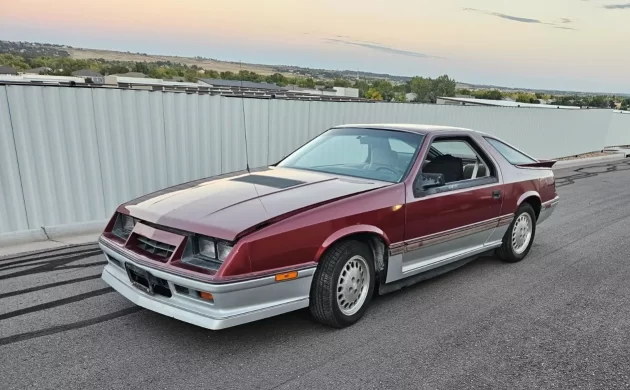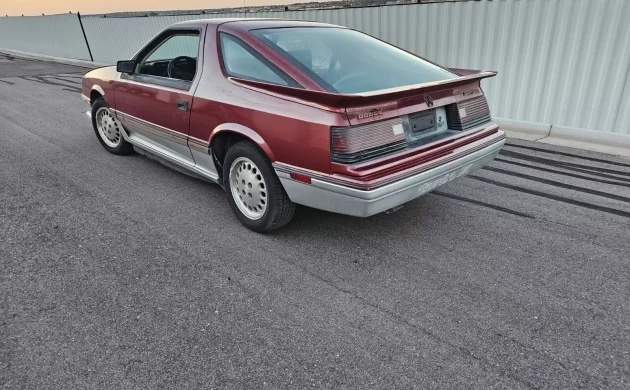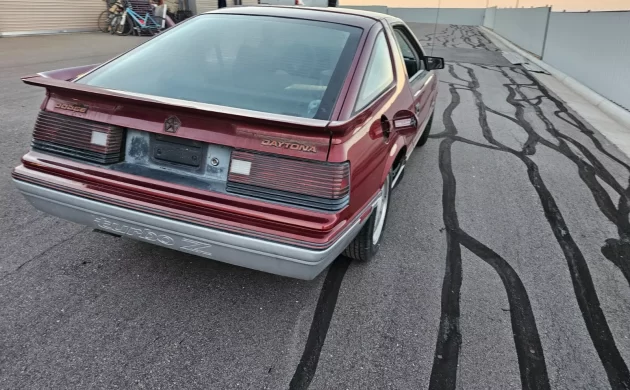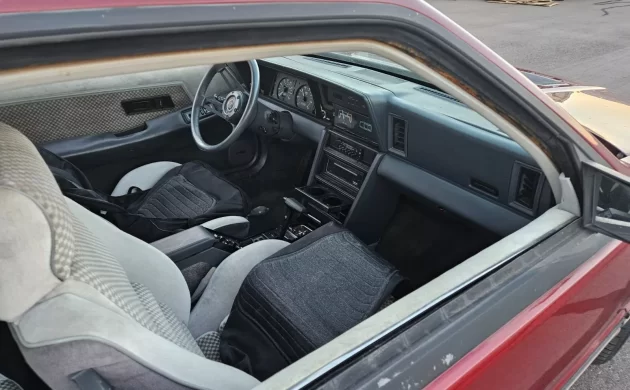When you go to Taco Bell to enjoy authentic Mexican food, did you ever think that everything there is simply a combination of a limited number of ingredients? While nobody is knocking Taco Bell for this, it is a way for the restaurant to save money, space, and time. When Chrysler introduced the K-Car for the 1982 model year, who would have ever thought that this simple platform would end up being the backbone of the company’s product line for more than a decade? Using the same basic parts, the company offered economy cars, minivans, luxury cars, a limousine, and even a muscle car of sorts. In 1984, Dodge introduced a K-platform-based muscle car with the Daytona name to challenge the Camaro, Firebird, Mustang, and all their various variants. Cars like this 1984 Dodge Daytona Turbo Z found quite a following. Would you like to have one in your garage today?
To understand the decision to use the K-platform for almost every passenger product except for the Omni-derived and rear wheel drive sedans that remained, you have to look at the market from Chrysler’s perspective. First off, the company came disturbingly close to bankruptcy. A huge government-guaranteed loan was still outstanding, and the company was still trying to get on firm financial footing. Creating an almost new platform was a huge financial risk that the company had to take. It also made good sense to use that platform for other products to lower costs and decrease the number of parts that dealers needed to have on hand. It was just that Chrysler took that policy to an extreme over the next decade.
It is also hard for us to look back on this era and understand the outside forces that were influencing automobile production. Government fuel mileage and safety laws had a death grip on the industry, and politicians were constantly scheming to tighten these even more as time went on. Efficient computer control of the combustion process, more efficient transmissions with a dizzying number of gears, and other technological marvels were still on the drawing board at this time. To make their cars get better fuel mileage, the industry was making a hard turn towards front-wheel-drive and four-cylinder powerplants. Customers used to big V-8s pushing around heavy, comfortable land barges would have a hard time adjusting to the new normal across the board.
While all of this front-wheel-drive nonsense was depressing to performance-loving customers, Chrysler surprised them with a muscle car of sorts in 1984. The Dodge Daytona and the Chrysler Laser were yet another variation of the K-platform, now called the G-platform, which was a two-door hatchback with sporty lines and a choice of two different 2.2-liter four-cylinder engines. The K-car powerplant could be had in regular form to the tune of 92 horsepower, or with a turbocharger. It was that turbocharged engine’s 142 horsepower that made these cars somewhat competitive with the other muscle cars of the time. Once tuners got ahold of the 2.2, there were quite a few rear wheel drive V-8s that got surprised during impromptu stoplight drag races by gussied up K-cars.
It didn’t hurt that the Daytona and Laser were handsomely styled as well. Chrysler managed to get a Dodge Daytona product placement in the popular crime drama “Hunter” on TV. Each week, customers saw Hunter’s partner wheeling around in a loaded Dodge Daytona Turbo Z (in this exact color scheme) while he made do in stoic cop fashion with the ubiquitous beat-up rear wheel drive undercover police sedan that fooled absolutely nobody. The Daytona ended up being a sales hit, the Chrysler Laser less so, and these sporty K-variants soldiered on until replaced by Mitsubishi-made Dodge Avenger in 1995. During that long production run the car was restyled in 1987 and in 1992, and even had a Shelby variant for some time.
Today it is rare to find an early version of the front-wheel-drive Daytona. This example has just 50,108 miles on the odometer and is said to run well. The seller tells us that it has no rust or other major body damage and has a good set of tires. As you can see from the pictures above, the car is in fair condition for its age. There are some front seat upholstery issues and some freshening would help bring it back to life for any Radwood appearances you might have planned. Also in the car’s favor is a laundry list of options, which include an automatic transmission, air conditioning, an alarm system, alloy wheels, an AM/FM stereo with a cassette player, cruise control, power windows, power locks, a tilt steering wheel, and a tilt steering wheel.
Looking back on the Daytona and Laser today, it is obvious that Chrysler did a lot with a limited set of ingredients. Cars such as this brought the company back from the brink and provided customers with some distinctive designs in a decade that saw more than its fair share of forgettable automobiles. Hopefully, a reader will purchase this eighties icon and bring it back to showroom condition. The Daytona and Laser of this era don’t deserve to be forgotten.
If you were one of those kids who watched “Hunter” back in the day and fell in love with the 1984 Dodge Daytona Turbo Z that Dee Dee drove, then you are in luck. This 50K mile version is for sale on eBay in Parker, Colorado. Bidding is currently sitting at $3,000 with just two days to go on this eighties icon.







I drove the turbo laser version of this car in the late 80’s. I don’t remember the exact year but it was not new at that time. It was a stick, the turbo lag was intense, but the car was a lot of fun. Later I would own several Saabs from the early 2000’s and they had managed to resolve the turbo lag. My wife’s VW has a turbo, it took me several months and a trip alone in the car to realize that the turbo was the source of power.
Bought twin to this when they came out, but mine was a stick. Put 100,000 miles on it and was great fun. Should have kept it.
Our ’86 Turbo Z 5 speed was a ball to drive. Once we got used to the turbo lag it turned out to be a good autocross car. Was a great highway runner with the big comfortable seats.
I would prefer Dee Dee.
Brass cupcake!
Sorry, you prefer men.
McCall? ;)
“When you go to Taco Bell to enjoy authentic Mexican food,” I read the whole article trying to find the punch line, but nothing.
Lol! Same here. The BF guys need to do some traveling soon.
Turbo lag is a phenomenon caused by not being at the correct rpm to execute the maneuver. From a stop the throttle needs to be steadily opened before WOT.
Winding up ↩️ the turbo Nelson.
Correct
Fun car, when things all work at the same time. I had a loaded black on black one. Love at 1st sight.
I broke the 5 speed. The secondary shaft blew out the case at the end bearing.
Sold it fast after getting it back on the road.
I rev’d it up and dumped it and the secondary shaft came threw the case. My car had 1700 miles on it. I took it back for warranty work and at 7500 miles traded in it on an older C3 corvette. It was fun while it lasted.
They were nice looking at the time and still look pretty good, but quality was terrible.
Great writeup Jeff!
At least he’s not doing Mexican restaurant reviews.
I think he forgot to put the ” ” around the word authentic.
I do get the point he was going for.
I will bet you are correct.
I didn’t forget. It was a bit of “tongue in cheek” humor. I do know what real Mexican food is. We had a place around here that lasted about a month that served really, really real Mexican food and it was fantastic. Now, we have a handful of different Mexican restaurants with the same exact menus serving the exact same food. Only the chips and salsa are slightly different at each place. It seems that the only restaurants that survive in the rural South are fast food, meat and three, and Mexican places. Such is life…
I am glad you enjoyed the write-up!
Jeff
Jeff, Yep, same here in GA.
Back in the northeast, we had all sorts of small family owned restaurants and sub/pizza shops.
Here, it is nothing but fast food & chain restaurants.
It seems that the only independent restaurants around here are Mexican.
SOLD for $4,000.